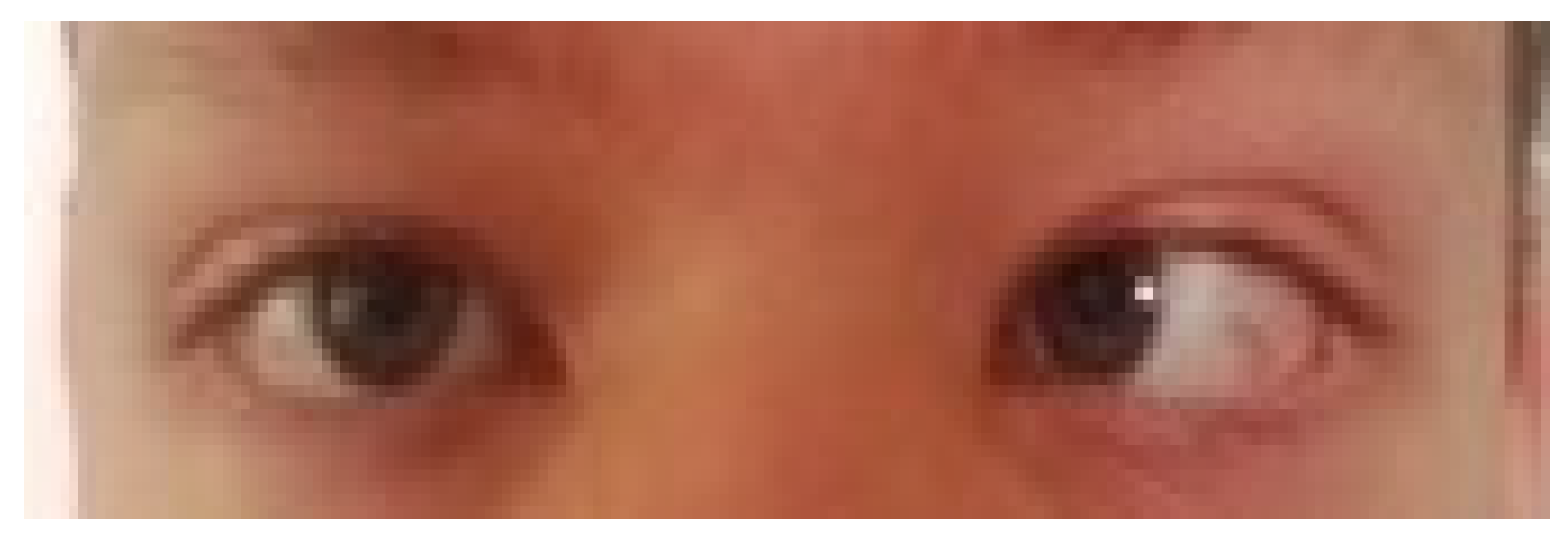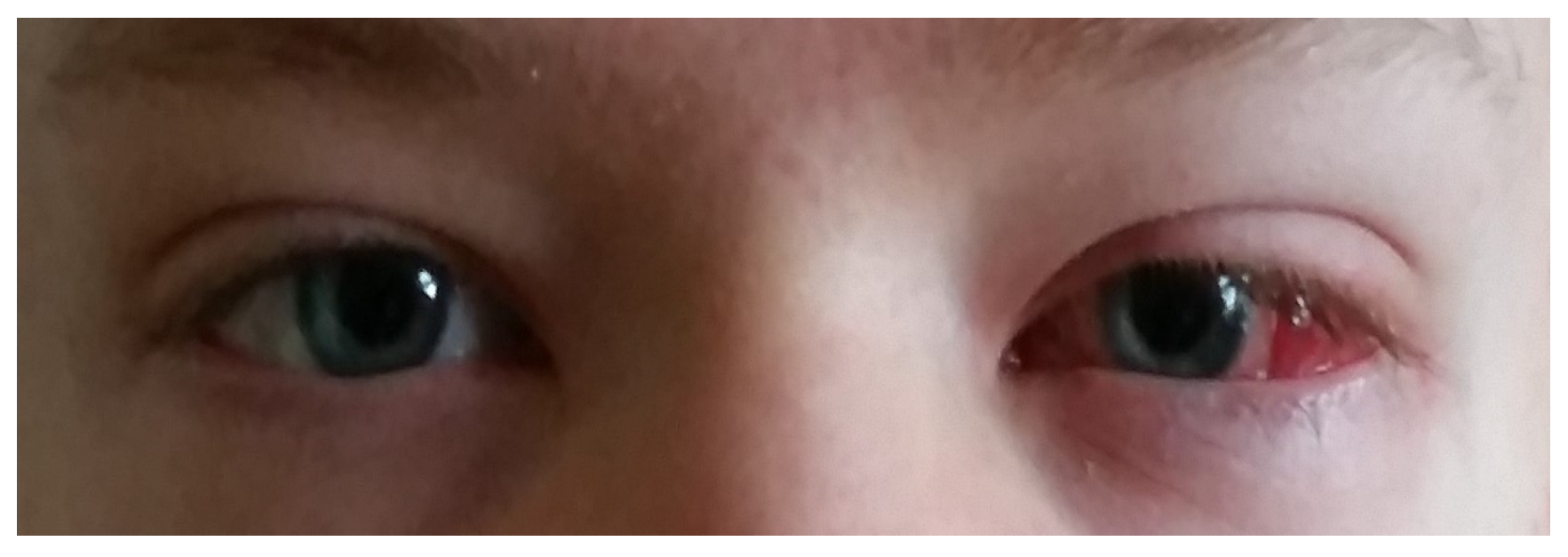A Preliminary Study of the Occurrence of Genetic Changes in mtDNA in the Muscles in Children Treated for Strabismus
Abstract
1. Introduction
2. Materials and Methods
2.1. Study Subjects
2.2. Preparation of Enriched mtDNA Samples
2.3. NGS Sequencing of mtDNA
3. Results
4. Discussion
4.1. Anatomy and Physiology of Extraocular Muscles
4.2. Molecular Specificity of Extraocular Muscles
4.3. Extraocular Muscles of Adults with Strabismus
4.4. Extraocular Muscles in Pediatric Strabismus
4.5. Molecular Genetics of Strabismus
Author Contributions
Funding
Institutional Review Board Statement
Informed Consent Statement
Data Availability Statement
Conflicts of Interest
References
- Strabismus Surgery—American Association for Pediatric Ophthalmology and Strabismus. Available online: https://aapos.org (accessed on 5 November 2020).
- Coyne, L.P.; Chen, X.J. Consequences of inner mitochondrial membrane protein misfolding. Mitochondrion 2019, 49, 46–55. [Google Scholar] [CrossRef] [PubMed]
- Simoncini, C.; Siciliano, G.; Tognoni, G.; Mancuso, M. Mitochondrial ANT-1 related adPEO leading to cognitive impairment: Is there a link? Acta Myol. 2017, 36, 25–27. [Google Scholar] [PubMed]
- Man, C.Y.W.; Chinnery, P.F.; Griffiths, P.G. Extraocular muscles have fundamentally distinct properties that make them selectively vulnerable to certain disorders. Neuromuscul. Disord. 2005, 15, 17–23. [Google Scholar] [CrossRef]
- Wright, K.W. Pediatric Ophthalmology and Strabismus; Mosby: Boston, MA, USA, 1995; pp. 96–97. [Google Scholar]
- Janbaz, A.H.; Lindström, M.; Liu, J.X.; Pedrosa Domellöf, F. Intermediate filaments in the human extraocular muscles. Investig. Ophthalmol. Vis. Sci. 2014, 55, 5151–5159. [Google Scholar] [CrossRef] [PubMed]
- Bottinelli, R.; Reggiani, C. Human skeletal muscle fibres: Molecular and functional diversity. Prog. Biophys. Mol. Biol. 2000, 73, 195–262. [Google Scholar] [CrossRef] [PubMed]
- Antunes-Foschini, R.S.; Miyashita, D.; Bicas, H.E.; McLoon, L.K. Activated satellite cells in medial rectus muscles of patients with strabismus. Investig. Ophthalmol. Vis. Sci. 2008, 49, 215–220. [Google Scholar] [CrossRef] [PubMed]
- Jung, S.K.; Choi, J.S.; Shin, S.Y. Change in the antioxidative capacity of extraocular muscles in patients with exotropia. Graefes Arch. Clin. Exp. Ophthalmol. 2015, 253, 551–556. [Google Scholar] [CrossRef] [PubMed]
- Li, J.; Shen, C. Histological and ultrastructural studies of extraocular muscle proprioceptor in concomitant strabismus. Zhonghua Yan Ke Za Zhi 2001, 37, 200–202. [Google Scholar] [PubMed]
- Yamane, T.; Matsuo, T.; Hasebe, S.; Ohtsuki, H. Clinical correlations of aggrecan in the resected medial rectus muscle of patients with intermittent exotropia. Acta Med. Okayama 2003, 57, 199–204. [Google Scholar]
- Liu, G.X.; Kong, Q.L.; Hu, C.; Yu, S.J. The changes of extracellular matrix molecules in the resected medial rectus muscle of patients with concomitant exotropia. Zhonghua Yan Ke Za Zhi 2007, 43, 618–621. [Google Scholar]
- Zuo, X.H.; Liu, G.X. Study on the changes of fibronectin in the resected medial rectus of patients with concomitant exotropia. Zhonghua Yan Ke Za Zhi 2012, 48, 794–798. [Google Scholar] [PubMed]
- Martinez, A.J.; Biglan, A.W.; Hiles, D.A. Structural features of extraocular muscles of children with strabismus. Arch. Ophthalmol. 1980, 98, 533–539. [Google Scholar] [CrossRef] [PubMed]
- Park, S.E.; Sa, H.S. Innervated myotendinous cylinders alterations in human extraocular muscles in patients with strabismus. Korean J. Ophthalmol. 2009, 23, 93–99. [Google Scholar] [CrossRef] [PubMed][Green Version]
- Domenici-Lombardo, L.; Corsi, M.; Mencucci, R.; Scrivanti, M.; Faussone-Pellegrini, M.S.; Salvi, G. Extraocular muscles in congenital strabismus: Muscle fiber and nerve ending ultrastructure according to different regions. Ophthalmologica 1992, 205, 29–39. [Google Scholar] [CrossRef]
- Corsi, M.; Sodi, A.; Salvi, G.; Faussone-Pellegrini, M.S. Morphological study of extraocular muscle proprioceptor alterations in congenital strabismus. Ophthalmologica. 1990, 2003, 154–163. [Google Scholar] [CrossRef] [PubMed]
- Kim, S.H.; Yi, S.T.; Cho, Y.A.; Uhm, C.S. Ultrastructural study of extraocular muscle tendon axonal profiles in infantile and intermittent exotropia. Acta Ophthalmol. Scand. 2006, 84, 182–187. [Google Scholar] [CrossRef] [PubMed]
- Kim, S.H.; Cho, Y.A.; Park, C.H.; Uhm, C.S. The ultrastructural changes of tendon axonal profiles of medial rectus muscles according to duration in patients with intermittent exotropia. Eye 2008, 22, 1076–1081. [Google Scholar] [CrossRef][Green Version]
- Michaelides, M.; Moore, A.T. The genetics of strabismus. J. Med. Genet. 2004, 41, 641–646. [Google Scholar] [CrossRef] [PubMed]
- Khan, A.O.; Shinwari, J.; Al Sharif, L.; Khalil, D.; Al-Gehedan, S.; Tassan, N.A. Infantile esotropia could be oligogenic and allelic with Duane retraction syndrome. Mol. Vis. 2011, 17, 1997–2002. [Google Scholar]
- Fischer, M.D.; Budak, M.T.; Bakay, M.; Gorospe, J.R.; Kjellgren, D.; Pedrosa-Domellöf, F.; Hoffman, E.P.; Khurana, T.S. Definition of the unique human extraocular muscle allotype by expression profiling. Physiol. Genom. 2005, 11, 283–291. [Google Scholar] [CrossRef]
- Altick, A.L.; Feng, C.Y.; Schlauch, K.; Johnson, L.A.; von Bartheld, C.S. Differences in gene expression between strabismic and normal human extraocular muscles. Investig. Ophthalmol. Vis. Sci. 2012, 53, 5168–5177. [Google Scholar] [CrossRef] [PubMed]
- Zhu, Y.; Deng, D.; Long, C.; Jin, G.; Zhang, Q.; Shen, H. Abnormal expression of seven myogenesis-related genes in extraocular muscles of patients with concomitant strabismus. Mol. Med. Rep. 2013, 7, 217–222. [Google Scholar] [CrossRef] [PubMed][Green Version]
- Kitada, M.; Matsuo, T.; Yamane, T.; Hasebe, S.; Ohtsuki, H. Different levels of TIMPs and MMPs in human lateral and medial rectus muscle tissue excised from strabismic patients. Strabismus 2003, 11, 145–155. [Google Scholar] [CrossRef] [PubMed]
- Sharer, J.D. The adenine nucleotide translocase type 1 (ANT1): A new factor in mitochondrial disease. IUBMB Life 2005, 57, 607–614. [Google Scholar] [CrossRef]
- Arbogast, S.; Kotzur, H.; Frank, C.; Compagnone, N.; Sutra, T.; Pillard, F.; Pietri, S.; Hmada N, Moussa DMA, Bride J, Françonnet S, Mercier J, Cristol JP, Dabauvalle MC, Laoudj-Chenivesse, D. ANT1 overexpression models: Some similarities with facioscapulohumeral muscular dystrophy. Redox Biol. 2022, 56, 102450. [Google Scholar] [CrossRef]


| Angle of Deviation above 10 Degrees | |||||
|---|---|---|---|---|---|
| Gender | DOB | Date of Surgery | Type of Surgery | Morphological Assessment | mtDNA Mutation Assessment |
| M | October 2002 | 15 July 2014 | Strabismus convergens OS: medial rectus muscle recession, lateral rectus muscle resection | Without pathological changes | ANT1 del C |
| M | February 2008 | 9 June 2014 | Strabismus convergens OS: medial rectus muscle recession, lateral rectus muscle resection | Without pathological changes | No signs of mutation |
| M | July 2010 | 3 June 2014 | Strabismus convergens OS: medial rectus muscle recession, lateral rectus muscle resection | Without pathological changes | No signs of mutation |
| M | December 2005 | 20 May 2014 | Strabismus convergens OD: medial rectus muscle recession, lateral rectus muscle resection | Without pathological changes | ANT1 del G |
| F | November 2011 | 4 June 2014 | Strabismus convergens OD: medial rectus muscle recession, lateral rectus muscle resection | Features of low-grade muscle fiber atrophy | ANT1 del A |
| F | July 2009 | 21 May 2014 | Strabismus convergens OS: medial rectus muscle recession, lateral rectus muscle resection | Features of atrophy of muscle fibers in the marginal part of the bundle | ANT1 del G |
| F | July 2003 | 26 August 2014 | Strabismus convergens OS: medial rectus muscle recession, lateral rectus muscle resection | Without pathological changes | ANT1 del T, ANT1 C>A |
| F | November 2008 | 12 August 2014 | Strabismus convergens OS: medial rectus muscle recession, lateral rectus muscle resection | Without pathological changes | ANT1 del G |
| Angle Deviation below 10 Degrees | |||||
|---|---|---|---|---|---|
| Gender | DOB | Date of Surgery | Type of Surgery | Morphological Assessment | mtDNA Mutation Assessment |
| F | October 2002 | 22 July 2014 | Strabismus divergens OD: medial rectus muscle resection | Features of focal atrophy of muscle fibers in the marginal part | ANT1 del T |
| M | September 2009 | 28 May 2014 | Strabismus divergens OD: medial rectus muscle resection | Without pathological changes | ANT 1 C>T bp 269 |
| M | December 2007 | 13 August 2014 | Strabismus divergens OS: medial rectus muscle resection | Without pathological changes | ANT1 del T, ANT1 C>A |
| F | October 2010 | 23 July 2014 | Strabismus divergens OS: medial rectus muscle resection | Without pathological changes | ANT1 del G |
| F | August 2011 | 8 July 2014 | Strabismus divergens OD: medial rectus muscle resection | Without pathological changes | ANT 1 C>T bp 269 |
| F | November 1999 | 11 June 2014 | Strabismus divergens OS: medial rectus muscle resection | Without pathological changes | ANT1 del T |
| M | February 2002 | 12 August 2014 | Strabismus divergens OS: medial rectus muscle resection | Without pathological changes | No signs of mutation |
Disclaimer/Publisher’s Note: The statements, opinions and data contained in all publications are solely those of the individual author(s) and contributor(s) and not of MDPI and/or the editor(s). MDPI and/or the editor(s) disclaim responsibility for any injury to people or property resulting from any ideas, methods, instructions or products referred to in the content. |
© 2024 by the authors. Licensee MDPI, Basel, Switzerland. This article is an open access article distributed under the terms and conditions of the Creative Commons Attribution (CC BY) license (https://creativecommons.org/licenses/by/4.0/).
Share and Cite
Pawłowski, W.; Reszeć-Giełażyn, J.; Cechowska-Pasko, M.; Urban, B.; Bakunowicz-Łazarczyk, A. A Preliminary Study of the Occurrence of Genetic Changes in mtDNA in the Muscles in Children Treated for Strabismus. J. Clin. Med. 2024, 13, 4041. https://doi.org/10.3390/jcm13144041
Pawłowski W, Reszeć-Giełażyn J, Cechowska-Pasko M, Urban B, Bakunowicz-Łazarczyk A. A Preliminary Study of the Occurrence of Genetic Changes in mtDNA in the Muscles in Children Treated for Strabismus. Journal of Clinical Medicine. 2024; 13(14):4041. https://doi.org/10.3390/jcm13144041
Chicago/Turabian StylePawłowski, Wojciech, Joanna Reszeć-Giełażyn, Marzanna Cechowska-Pasko, Beata Urban, and Alina Bakunowicz-Łazarczyk. 2024. "A Preliminary Study of the Occurrence of Genetic Changes in mtDNA in the Muscles in Children Treated for Strabismus" Journal of Clinical Medicine 13, no. 14: 4041. https://doi.org/10.3390/jcm13144041
APA StylePawłowski, W., Reszeć-Giełażyn, J., Cechowska-Pasko, M., Urban, B., & Bakunowicz-Łazarczyk, A. (2024). A Preliminary Study of the Occurrence of Genetic Changes in mtDNA in the Muscles in Children Treated for Strabismus. Journal of Clinical Medicine, 13(14), 4041. https://doi.org/10.3390/jcm13144041







